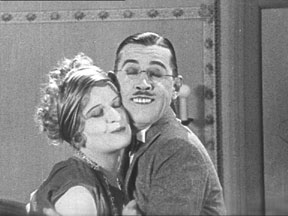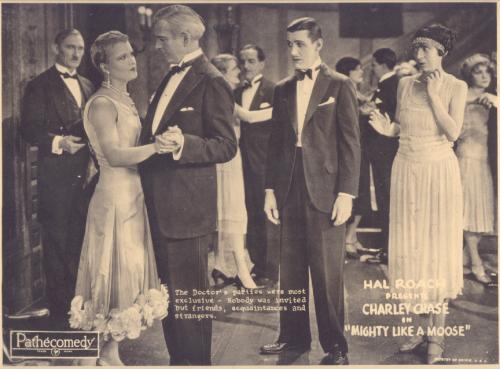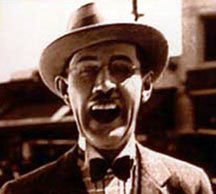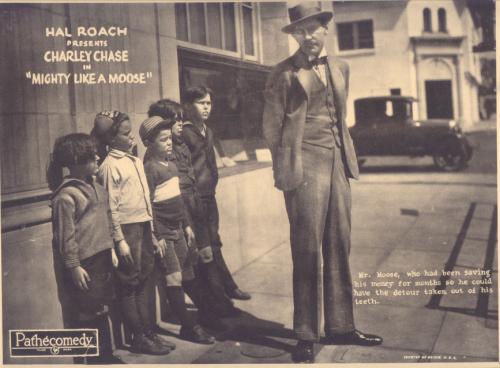Charley Chase's Mighty Like a Moose (1926)
****
 Many critics and aficionados consider Mighty Like a
Moose to be the finest of Charley Chase's silent
comedies. Sure, film historians have cited other contenders for this
title -- His Wooden Wedding (1925), Limousine Love (1928), even the mediocre Movie
Night (1929), which Walter Kerr and Gerald Mast (who both severely underrated the comedian's merits) regarded as Chase's
best film. None of these comedies, however, match
Mighty Like a Moose in terms of its premise, direction, and execution.
Many critics and aficionados consider Mighty Like a
Moose to be the finest of Charley Chase's silent
comedies. Sure, film historians have cited other contenders for this
title -- His Wooden Wedding (1925), Limousine Love (1928), even the mediocre Movie
Night (1929), which Walter Kerr and Gerald Mast (who both severely underrated the comedian's merits) regarded as Chase's
best film. None of these comedies, however, match
Mighty Like a Moose in terms of its premise, direction, and execution.
The plot of Mighty Like a Moose, though it
features some of Chase's favorite comic devices, sets it apart from
most of his other two-reelers. Even though Chase usually kept his name
unchanged for his characters in his films, he is named Mr. Moose in
this one (hence the title). Mr. Moose is unfortunately plagued by a set
of buck teeth, which cause the neighborhood children (Our Gang clones, no doubt)
to make fun of him, reminiscent of a scene in his earlier Fraidy Cat
(1924). As a typically flippant intertitle tells us when the film opens,
Mr. Moose is cursed with a face that can stop a clock and his wife (Vivien Oakland), who
has a large nose, has a face that can start it up again. Mr. and Mrs. Moose,
without telling one another, both get face-lifts to surprise each other. After
taking a "before and after" picture at the doctor's and pocketing a false set of
buck teeth so people can identify him, Mr. Moose encounters his wife, after her
face lift, and neither recognizes one another. The two start to flirt and
eventually plan to go to a party with each other, each thinking how they
betrayed their spouse.
Both get home separately and don't notice one another, though they both try
to change clothes very quietly, trying not to make their spouse suspicious. In a
marvelously choreographed scene, similar to a scene in Buster Keaton's
The Navigator (1924) where both characters narrowly miss each
other, Mr. and Mrs. Moose walk around the house getting ready for the big party.
An especially funny and beautifully executed shot is the one where Mr. Moose is
on the second level of the house directly above his wife, both characters not
noticing each other and both moving around the estate as quietly as they can.
They go to the party, and while talking, admit to each other that they're
married. Mr. Moose spots some policemen on the premises, looking out for liquor
in the days of Prohibition, and both turn around. The authorities take a picture
of the couple and the party, and all the guests rush out in this raid.
 Returning home, Mr. Moose spots his date entering the house too, first
thinking how to get her out of the house, and then hearing her tell the maid
that she's Mrs. Moose with "alterations". The husband does a take, and then
thinks about how his wife betrayed him. He puts on his set of false teeth, walks
up to her and takes out a newspaper with the picture the police officers took of
her and her "boyfriend". He becomes angry at her and she rushes into her room
with feelings of shame. Mr. Moose then hatches a plan -- he takes out the false
teeth and dons a tuxedo, making him look like the wife's boyfriend. He dashes in
the room and tells Mrs. Moose that he can't live without her, then knocks on the
door without her looking making it look like her husband knocked on it, speeds
off, comes back as her husbands, yells at her, leaves, and comes back again as
her boyfriend. This scene eventually leads into a climactic fight between the
two men in Mrs. Moose's life, the husband and her "boyfriend". The fight, lifted
from the Max Linder feature Be My Wife (1920), is one of the
highlights of a great film, and a very inventive brawl it is. While this is
going on, Mrs. Moose spots a newspaper with the "Before and After" picture taken
of her husband, the way he looked before the operation and then sans the
buck teeth. She shows it to him, stopping him dead on his tracks, and he tries
to explain, but she wallops him in anger as the film ends.
Returning home, Mr. Moose spots his date entering the house too, first
thinking how to get her out of the house, and then hearing her tell the maid
that she's Mrs. Moose with "alterations". The husband does a take, and then
thinks about how his wife betrayed him. He puts on his set of false teeth, walks
up to her and takes out a newspaper with the picture the police officers took of
her and her "boyfriend". He becomes angry at her and she rushes into her room
with feelings of shame. Mr. Moose then hatches a plan -- he takes out the false
teeth and dons a tuxedo, making him look like the wife's boyfriend. He dashes in
the room and tells Mrs. Moose that he can't live without her, then knocks on the
door without her looking making it look like her husband knocked on it, speeds
off, comes back as her husbands, yells at her, leaves, and comes back again as
her boyfriend. This scene eventually leads into a climactic fight between the
two men in Mrs. Moose's life, the husband and her "boyfriend". The fight, lifted
from the Max Linder feature Be My Wife (1920), is one of the
highlights of a great film, and a very inventive brawl it is. While this is
going on, Mrs. Moose spots a newspaper with the "Before and After" picture taken
of her husband, the way he looked before the operation and then sans the
buck teeth. She shows it to him, stopping him dead on his tracks, and he tries
to explain, but she wallops him in anger as the film ends.
 The film succeeds in every scene it attempts to execute with one notable,
though forgivable, exception. The scene where Mr. Moose "fights" the boyfriend
is not completely believable because in a segment where both men, who are
obviously both played by Chase, run around swiftly, it is impossible for the
scene to happen in reality. This effect is made by use of quick editing. Chase,
who was more realistic than most of the film comedians of his era, couldn't make
this scene plausible outside of this film. What saves the scene is the way it
seems believable in the context of the film; the wife's reactions are genuine
and Chase's performance is excellent, certainly good enough to make the viewer
go along with the spirit of the film. In fact, even through the scene is quite
ridiculous, it remains the funniest and most memorable scene in the film.
The film succeeds in every scene it attempts to execute with one notable,
though forgivable, exception. The scene where Mr. Moose "fights" the boyfriend
is not completely believable because in a segment where both men, who are
obviously both played by Chase, run around swiftly, it is impossible for the
scene to happen in reality. This effect is made by use of quick editing. Chase,
who was more realistic than most of the film comedians of his era, couldn't make
this scene plausible outside of this film. What saves the scene is the way it
seems believable in the context of the film; the wife's reactions are genuine
and Chase's performance is excellent, certainly good enough to make the viewer
go along with the spirit of the film. In fact, even through the scene is quite
ridiculous, it remains the funniest and most memorable scene in the film.
Mighty Like a Moose is hailed as Charley Chase's best silent
film, or even his best film from any period in his career. It certainly deserves
this distinction. The film is a virtually perfect Chase film, made at the
apex of his popularity; Laurel & Hardy haven't officially teamed yet at Hal
Roach Studios to eclipse Chase's popularity. Mighty Like a Moose
was made with the director who arguably worked best with him, the talented Leo
McCarey (not incidentally, he was the man credited with the idea of teaming up
Laurel & Hardy).
Almost all of Chase's films from this period were consistently above average,
in fact, his following film released a month after Moose,
Crazy Like a Fox, is hailed as a classic as well. But the former
film is far superior. Crazy Like a Fox has Chase pretending to be
crazy in order to break up his arranged marriage, later discovering the girl he
actually wanted to marry was his intended wife in the arranged marriage. Where
the gags in Crazy chiefly arise from Charley's crazy actions,
Moose is a more solid film, with the laughs mainly coming from the
situations Charley gets into. Even though both films were directed by McCarey,
with equal assistance from Chase behind the camera, Moose is
better directed, and even, it can be said, more sophisticated. A ripe example of
the innovative direction in the film is the scene where Mr. and Mrs. Moose are
at the party, and Chase is confronted by a girl he wishes would leave him alone,
played by comedienne Gale Henry. The shot where Gale walks up to him is recorded
completely facing the floor, with the shot limited to only the performers' lower
extremities, and in this shot, Charley does a take using only his feet!
Mighty Like a Moose is a high point in the Charley Chase series and the summit of Chase's celebrated collaboration with director Leo McCarey. Mighty Like a Moose is a film
that places all of Charley Chase's talents on full display, a film whose merits remain unsurpassed in the Chase canon,
and arguably, unsurpassed in the field of short film comedy.
 Credits:
Credits:
"Mighty Like a Moose". Directed by Leo McCarey. With Charley Chase, Vivien
Oakland, Anne Howe, Charles Clary, Gale Henry, Malcolm Denny, Rolfe Sedan,
Charlie Hall, Harry Bowen, Buddy the Dog.
Supervised by F. Richard Jones.
Photographed by Len Powers. Edited by Richard Currier. Titles by H.M. Walker.
Produced by Hal Roach.
Released on July 18, 1926.
Mighty Like a Moose lobby cards courtesy of Cole Johnson.
 Back to the main page of "The World
of Charley Chase"
Back to the main page of "The World
of Charley Chase"
 Many critics and aficionados consider Mighty Like a
Moose to be the finest of Charley Chase's silent
comedies. Sure, film historians have cited other contenders for this
title -- His Wooden Wedding (1925), Limousine Love (1928), even the mediocre Movie
Night (1929), which Walter Kerr and Gerald Mast (who both severely underrated the comedian's merits) regarded as Chase's
best film. None of these comedies, however, match
Mighty Like a Moose in terms of its premise, direction, and execution.
Many critics and aficionados consider Mighty Like a
Moose to be the finest of Charley Chase's silent
comedies. Sure, film historians have cited other contenders for this
title -- His Wooden Wedding (1925), Limousine Love (1928), even the mediocre Movie
Night (1929), which Walter Kerr and Gerald Mast (who both severely underrated the comedian's merits) regarded as Chase's
best film. None of these comedies, however, match
Mighty Like a Moose in terms of its premise, direction, and execution.
 Returning home, Mr. Moose spots his date entering the house too, first
thinking how to get her out of the house, and then hearing her tell the maid
that she's Mrs. Moose with "alterations". The husband does a take, and then
thinks about how his wife betrayed him. He puts on his set of false teeth, walks
up to her and takes out a newspaper with the picture the police officers took of
her and her "boyfriend". He becomes angry at her and she rushes into her room
with feelings of shame. Mr. Moose then hatches a plan -- he takes out the false
teeth and dons a tuxedo, making him look like the wife's boyfriend. He dashes in
the room and tells Mrs. Moose that he can't live without her, then knocks on the
door without her looking making it look like her husband knocked on it, speeds
off, comes back as her husbands, yells at her, leaves, and comes back again as
her boyfriend. This scene eventually leads into a climactic fight between the
two men in Mrs. Moose's life, the husband and her "boyfriend". The fight, lifted
from the Max Linder feature Be My Wife (1920), is one of the
highlights of a great film, and a very inventive brawl it is. While this is
going on, Mrs. Moose spots a newspaper with the "Before and After" picture taken
of her husband, the way he looked before the operation and then sans the
buck teeth. She shows it to him, stopping him dead on his tracks, and he tries
to explain, but she wallops him in anger as the film ends.
Returning home, Mr. Moose spots his date entering the house too, first
thinking how to get her out of the house, and then hearing her tell the maid
that she's Mrs. Moose with "alterations". The husband does a take, and then
thinks about how his wife betrayed him. He puts on his set of false teeth, walks
up to her and takes out a newspaper with the picture the police officers took of
her and her "boyfriend". He becomes angry at her and she rushes into her room
with feelings of shame. Mr. Moose then hatches a plan -- he takes out the false
teeth and dons a tuxedo, making him look like the wife's boyfriend. He dashes in
the room and tells Mrs. Moose that he can't live without her, then knocks on the
door without her looking making it look like her husband knocked on it, speeds
off, comes back as her husbands, yells at her, leaves, and comes back again as
her boyfriend. This scene eventually leads into a climactic fight between the
two men in Mrs. Moose's life, the husband and her "boyfriend". The fight, lifted
from the Max Linder feature Be My Wife (1920), is one of the
highlights of a great film, and a very inventive brawl it is. While this is
going on, Mrs. Moose spots a newspaper with the "Before and After" picture taken
of her husband, the way he looked before the operation and then sans the
buck teeth. She shows it to him, stopping him dead on his tracks, and he tries
to explain, but she wallops him in anger as the film ends.
 The film succeeds in every scene it attempts to execute with one notable,
though forgivable, exception. The scene where Mr. Moose "fights" the boyfriend
is not completely believable because in a segment where both men, who are
obviously both played by Chase, run around swiftly, it is impossible for the
scene to happen in reality. This effect is made by use of quick editing. Chase,
who was more realistic than most of the film comedians of his era, couldn't make
this scene plausible outside of this film. What saves the scene is the way it
seems believable in the context of the film; the wife's reactions are genuine
and Chase's performance is excellent, certainly good enough to make the viewer
go along with the spirit of the film. In fact, even through the scene is quite
ridiculous, it remains the funniest and most memorable scene in the film.
The film succeeds in every scene it attempts to execute with one notable,
though forgivable, exception. The scene where Mr. Moose "fights" the boyfriend
is not completely believable because in a segment where both men, who are
obviously both played by Chase, run around swiftly, it is impossible for the
scene to happen in reality. This effect is made by use of quick editing. Chase,
who was more realistic than most of the film comedians of his era, couldn't make
this scene plausible outside of this film. What saves the scene is the way it
seems believable in the context of the film; the wife's reactions are genuine
and Chase's performance is excellent, certainly good enough to make the viewer
go along with the spirit of the film. In fact, even through the scene is quite
ridiculous, it remains the funniest and most memorable scene in the film.
